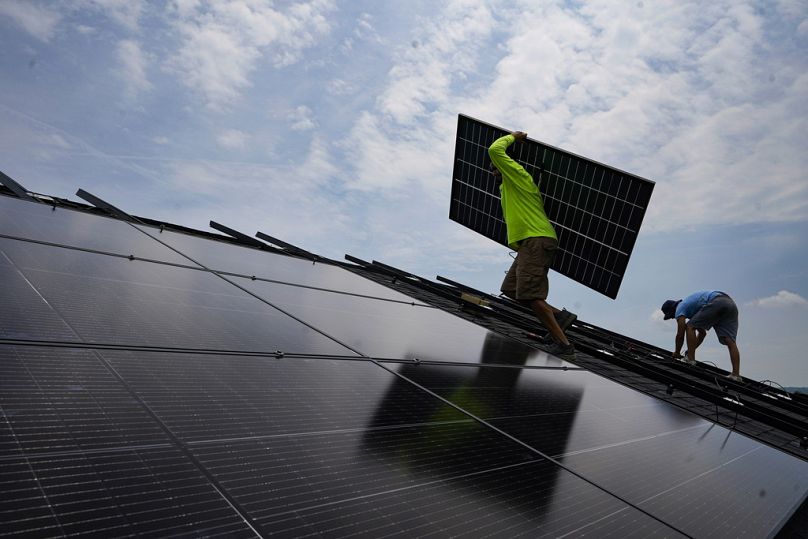We spoke to LinkedIn co-founder Allen Blue on the sidelines of COP28 to find out how to prepare the world’s workforce for a green future.
Tripling renewable energy capacity by 2030, rapidly cutting emissions and delivering vital climate finance.
The headlines from COP28 signal the scale of change needed to protect the future of the planet. But to bring about this change, we need people trained to do the jobs essential to making it happen.
With access to data from more than a billion users, employment-focused social media site LinkedIn released a report last month looking at where we stand on transforming our workforce.
It warned that a “significant sustainable skills shortage” is putting progress on the green transition at risk.
And according to co-founder of LinkedIn Allen Blue, we’re running out of time to close this green skills gap.
Green jobs are hiring - but skills are lacking to fill roles
When we think of green jobs, we usually associate them with climate actions - like installing renewable energy or ensuring water quality.
“The interesting thing about green skills, though, is that they are they're actually much more broadly distributed than you might consider,” Blue tells Euronews Green on the sidelines of COP28.
It isn’t just those that are obvious, he says - most jobs are likely to include the need for some green skills in the near future.
“These are green jobs, but it turns out every job - and we think more than 50 per cent of jobs - are going to be transformed to include some green skills as part of their skill portfolio.”
More and more companies are looking to hire people with green skills and ‘green hiring’, as the LinkedIn report calls it, is up around 25 per cent compared to other industries. Electric vehicle manufacturing, batteries, green tech - it's all expanding, which Blue says is great.
“But the issue is that the number of people with green skills remains about one in eight and one in nine in Europe,” he explains, and that number is only growing at a rate of around nine per cent every year. It isn’t enough to keep up with demand.
Without people with the skills to do the job of greening every aspect of our society, progress on all of the major transformational promises made at COP28 will move much slower than we need it to.
“We saw it in the tech world, but it took 15 years to actually overcome that lack of engineers and I’m not sure we’ve even overcome it,” Blue says. “I don’t think we have 15 years this time around.”
Who is responsible for closing the green skills gap?
“We need to start thinking about how we include - as part of our plans for making the transition - making sure that people have the necessary skills for making the transition,” Blue says.
He believes there are three primary players in ensuring there are enough people with green skills to get the job done.
The first is employers because, inevitably, the work is going to fall to those companies setting up wind farms, improving power grids and all of the other efforts involved in making the transition happen.
The list of potential fields is endless but it is going to be the companies that hire people that have to evaluate whether they are ready for the job.
And filling the gaps can mean thinking a bit differently about who and how they hire, Blue explains.
“They are the front line really in making sure that they are hiring in what we think of as a skills-first way. So instead of looking at experience or education pedigree, what you look at instead is whether people actually have the skills that are necessary.”
Blue again draws comparisons with the early days of Silicon Valley where there weren’t enough engineers and companies had to get extremely creative with how they trained their people. Intensive training programmes for existing employees and apprenticeship schemes for example.
To improve green skills, successful firms need to do the same thing to prepare for the green transition, he says.
The next biggest player is investors. Key to making the transition successful, Blue says, they have a responsibility to make sure there is a return on the environmental projects they are investing in because they are investing other people’s money. Like with all investments, risk is a big factor.
“When they see green projects, they frequently see risk,” he says, “One of the forms that risk takes is a lack of a trained workforce to actually work on a project.”
Understanding how they see risk is essential to making the whole process work. Investors setting aside money to ensure training happens is one way to both reduce that risk and begin to close the gap for green skills.
“It's a mechanism for them to de-risk the project, but it's also a mechanism by which we seriously believe that we can make better progress on the just transition,” Blue says.
Do governments have a role to play?
The third and possibly most important group is government.
Around the world, each country handles skills training differently. Some do it a lot better than others. Blue says we are often pointed towards Germany, Switzerland and Austria as examples of places with good skills training.
But everyone has a different method - the same approach isn’t going to work everywhere.
“Governments in some cases are going to be well prepared to be able to actually train people,” Blue explains.
“And in some cases, the best thing they can do is to require that as green projects are lining up at the companies, the investors are, in fact, making sure the training actually occurs.”
LinkedIn’s report also found that a 'green ceiling' is emerging, with women underrepresented in both green skills and green jobs.
Ninety per cent of women lack a single green skill or green work experience while 16 per cent of men have at least one green skill, the report says. There’s a gender gap in leadership positions too, with women making up only 20 per cent of high-level senior executives and 21 per cent of senior executives in green industries.
It is another task that governments may be best placed to take on by ensuring that training is carried out in a just way, bringing all groups up to the same level.
“There's been lots of commitment on the part of companies, individual companies among the ESG [Environmental, social and corporate governance] and so forth, to ensure that we have greater equality,” Blue says.
“So governments, especially when they're thinking about basically requiring companies and investors to invest in skilling, can be a little bit more prescriptive and say that they can invest in equitable skilling in those areas.
“We know those things are possible, they are possible and that they work,” Blue concludes.













